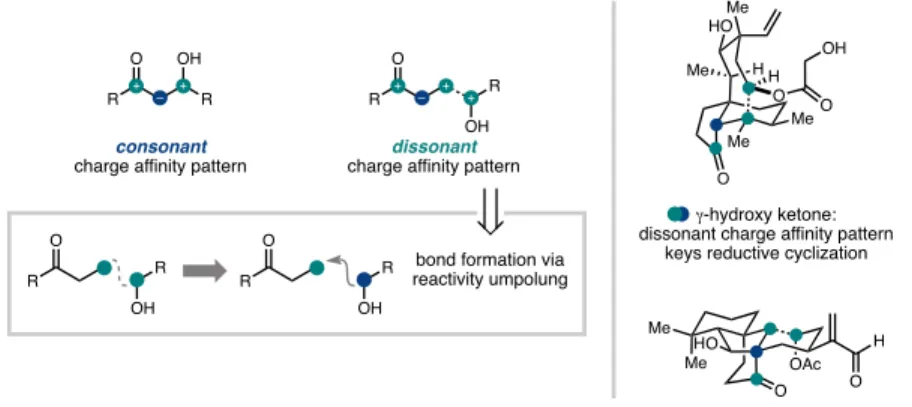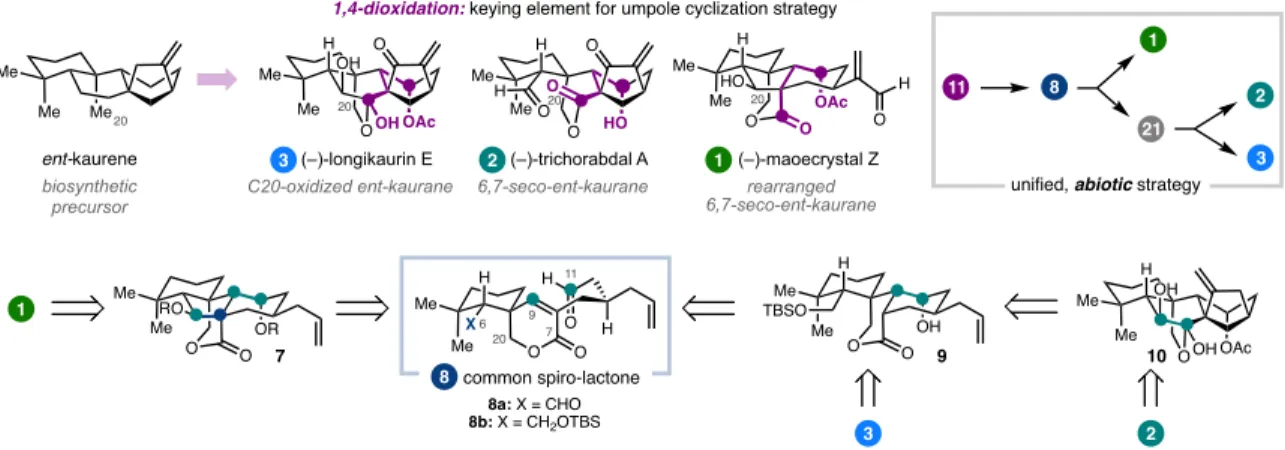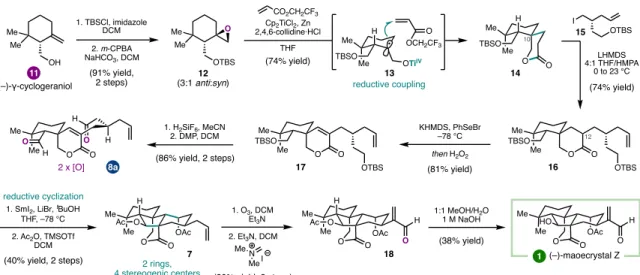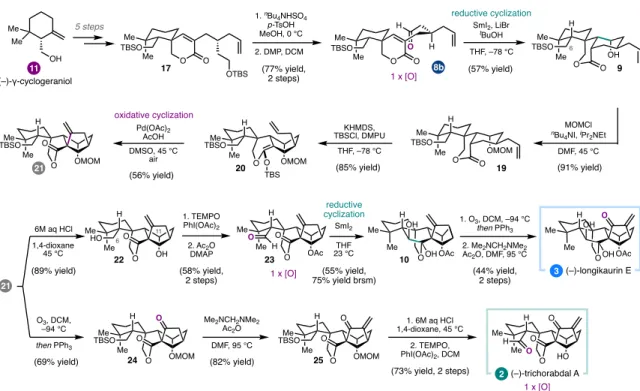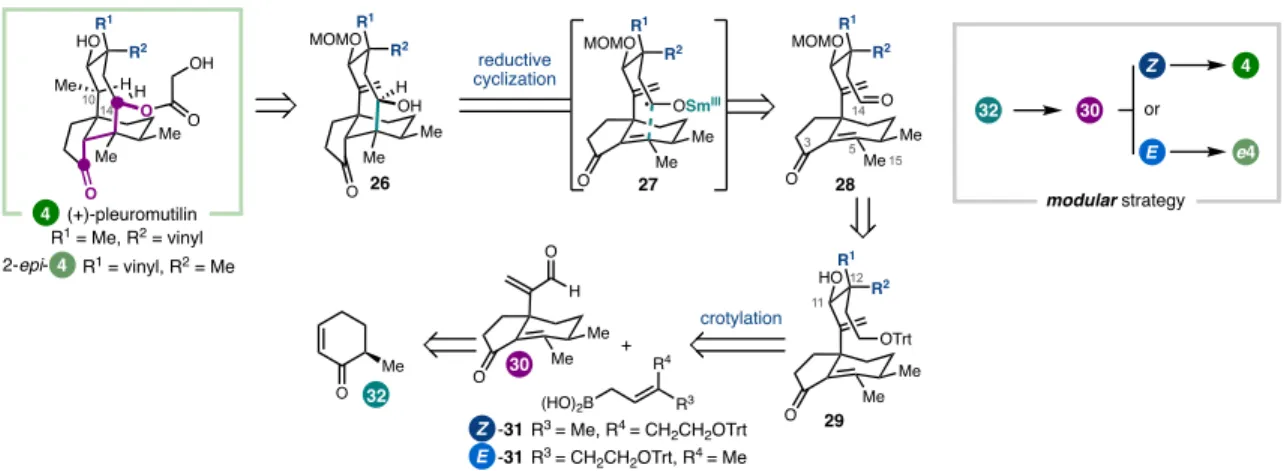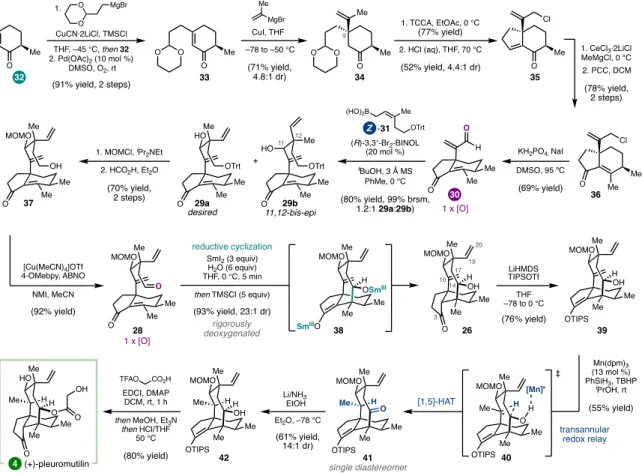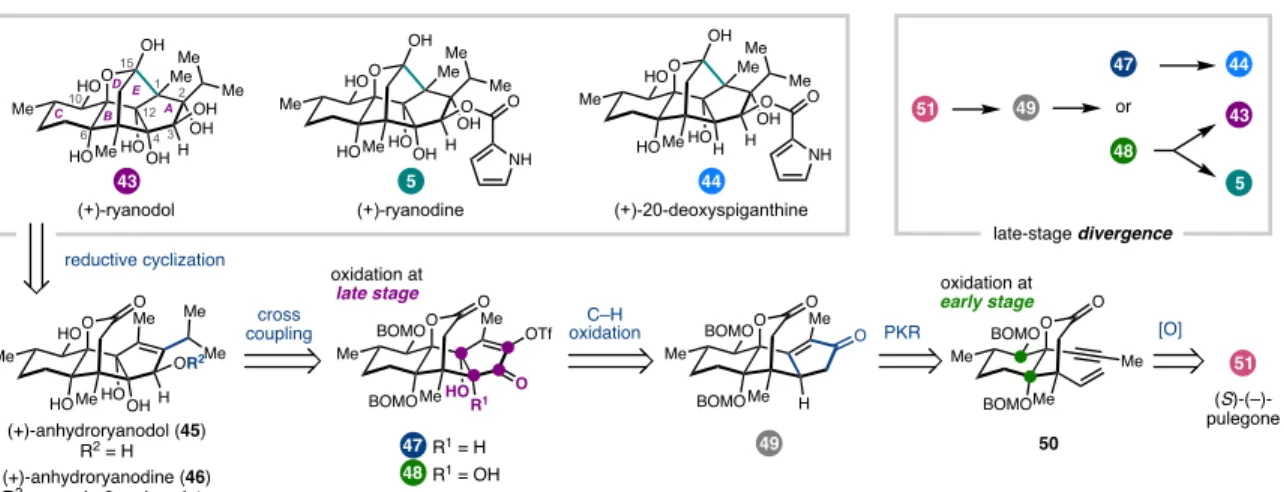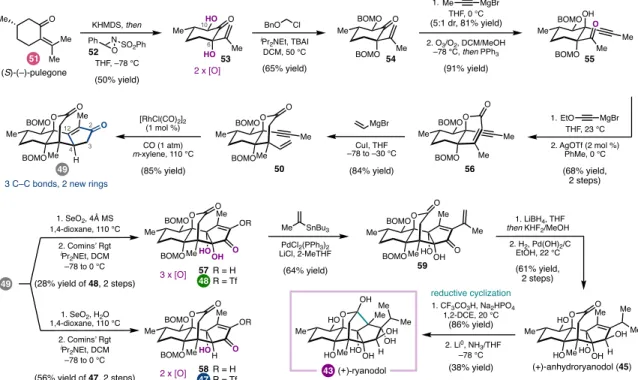The syntheses discussed can be roughly grouped into two types of strategies, both of which were guided by considerations of the oxidation pattern of the target (Figure 1.2). The G-hydroxyketone is an example of what Evans classified a 'dissonant' charge affinity pattern: the polarization imparted along the carbon chain between the oxygen functional groups is mismatched (Figure 1.3).5b,5c Carbon-carbon bond formation within this dissonant pathway requires a polarity inversion, or as Seebach defined, 'reactivity umpolung'.5c The location of this dissonant charge affinity pattern in each structure inspired synthetic strategies involving ring closure by Sm-mediated addition of an aldehyde-derived ketyl radical to an a,b -unsaturated cabonyl. 4,5 These syntheses highlight how this tactic is particularly effective when used to simultaneously form rings and introduce 1,4-dioxygenation patterns. The general strategy was guided by the identification of the γ-hydroxyketone motif spanning C7 to C11 (Figure 1.5).10 This dissonant charge affinity pattern was key to the use of a SmI2-mediated reductive cyclization to generate an umpol at C11- the position.
In the context of the preparation of mao-crystal Z, the use of a dialdehyde (8a) was envisioned to enable a cascade process; aldol reaction to close the central five-membered ring.11 Alternatively, SmI2-mediated monocyclization of 8b, followed by subsequent oxidative cyclization to form the. A SmI2-mediated intramolecular aldehyde-lactone pinacol coupling provided lactol 10 as a single diastereomer, another example of the strategic use of SmI2 to introduce dissonant oxidation patterns via C-C bond formation. Allylic chlorination of the isopropenyl group of 34 was carried out before intramolecular aldol condensation to give a.
At this stage, completion of the synthesis depended on the selective hydrogenation of the C10 exo-methylene in the presence of the C19 vinyl group. Indeed, chemoselective reduction of the exocyclic C10-C17 olefin was achieved; however, this reduction was accompanied by unexpected C14 oxidation. Deuterium labeling experiments have shown that this reaction proceeds via a transannular [1,5]-HAT redox relay, thermodynamically driven by the formation of the C14 ketone.
An advantage of this modular approach was the ability to easily prepare the 12-epi-4 framework by changing the relative configuration of the cyclization substrates at C12 (Figure 1.10).
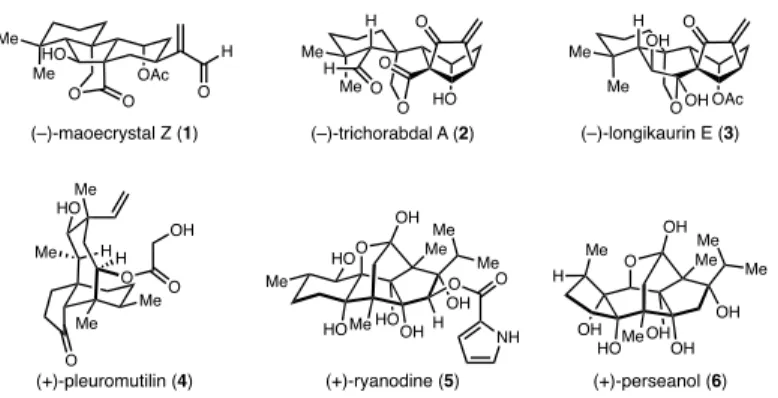
COMPCOMPLEX OXIDATION TOPOLOGY .1 Ryanodane Diterpenes
Isoryanodane Diterpenes
An interesting divergence is that none of the isoryanodanes isolated to date have a pyrrole-2-carboxylate ester like that found in ryanodine, although many retain potent insecticidal properties. Analysis of the oxidation patterns in 87 suggested that the A–B ring fusion diol could be accessed from tetracyclic alkene 88 , whereas the B–C ring fusion diol could be introduced early in the synthesis. Tetracyclic lactone 88 was dissected into two fragments that could be connected in two C–C bond-forming steps.
Through this four-step sequence, the B-C ring fusion diol was effectively introduced at the beginning of the synthesis with the correct relative stereochemistry. Synthesis of the A-ring fragment (91) began with alkylation of the zinc enolate of vinylog ester 99 (Figure 1.17). This reaction required extensive optimization to identify conditions that favored the formation of the seven-membered lactone.
This transformation was not part of the original plan; however, we continued our refinement efforts towards 6. After 1,2-addition of the methyl Grignard to the hydroxybenzoate 108, it was discovered that the diol 109 could be converted to the orthobenzoate 111 by treatment with trifluoroacetic acid, presumably via the dioxolenium ion 110. These three -step sequence, although outside the original synthetic design, allowed us to change the benzylidene acetal from a diol protecting group to an anchimeric directing group.
After enabling the installation of the C4 tertiary alcohol, it resumed the role as an alcohol protecting group, now in the form of an orthobenzoate. This series of transformations illustrates how some of the most strategic reaction sequences arise from exploiting the nascent reactivity of the molecule, rather than strictly adhering to a preconceived synthetic design. Tetracyclic alkene 111 was found to undergo selective allylic oxidation of the tertiary C–H bond at C2 to give allylic alcohol 112 .
Although the epoxidizing anhydroperseanol (87) was originally envisioned to perform a reductive cyclization similar to those used in the synthesis of ryanodine and ryanodole, it was realized that the synthesis could be directed by preparing the isomeric epoxide 113 instead. This type of reductive cyclization it was unprecedented; however, since 112 could be stereoselectively converted to 113 in good yield, it seemed worth pursuing. Interestingly, C2-des-iso-propyl-113 undergoes reductive cyclization in >50% yield (not shown), indicating that the steric bulk of the iso-propyl substituent likely slows the rate of C–C bond formation.
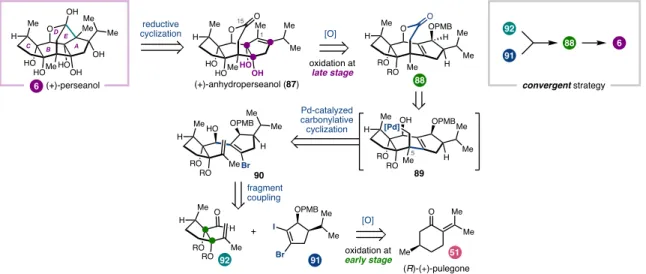
CONCLUDING REMARKS
The pleuromutilin drugs tiamulin and valnemulin bind to the RNA in the peptidyltransferase center of the ribosome. The calcium-ryanodine receptor complex of skeletal and cardiac muscle. isolation of the ryanodine receptor from the cardiac sarcoplasmic reticulum and identity with the structures of the feet. Symmetry-Driven Strategy for the Assembly of the Core Tetracycle of (+)-Ryanodine: Synthetic Utility of a Cobalt-Catalyzed Olefin Oxidation and α-Alkoxy Bridgehead Radical Reaction.
Total Unified Synthesis of 3-epi-Ryanodol, Cinnzeylanol, Cinncassiols A and B, and Structural Review of Natural Ryanodol and Cinnacasol. Structural determinants of high-affinity binding of ryanoids to the vertebrate skeletal muscle ryanodine receptor: a comparative molecular domain analysis. Toxicity and biochemical effects of Itol A on the brown planthopper, Nilaparvata Lugens (Stål) (Hemiptera: Delphacidae).
